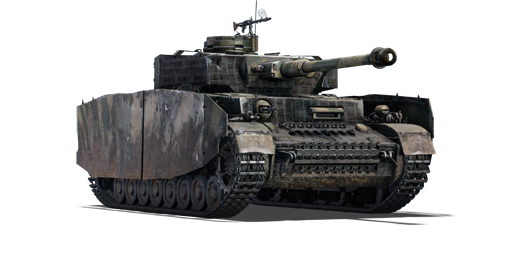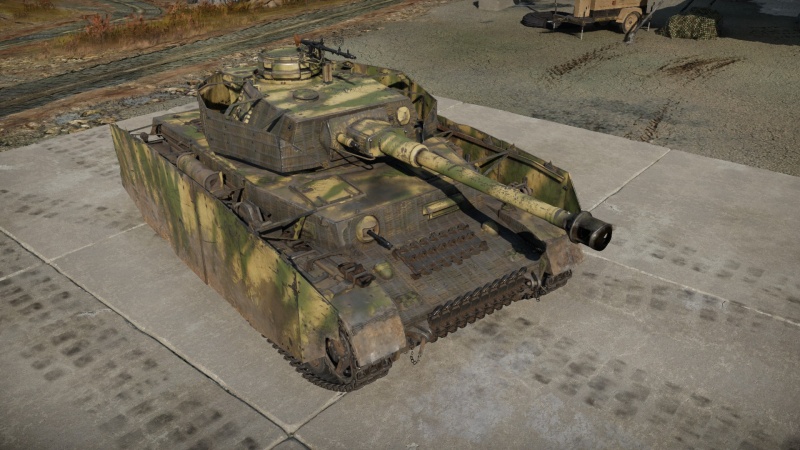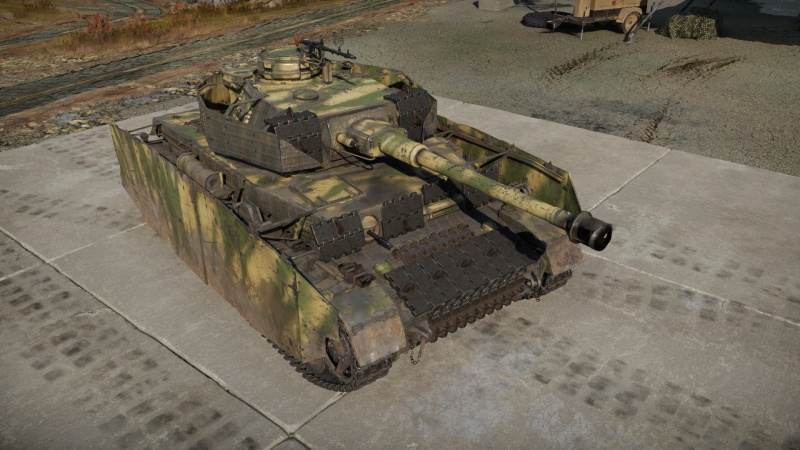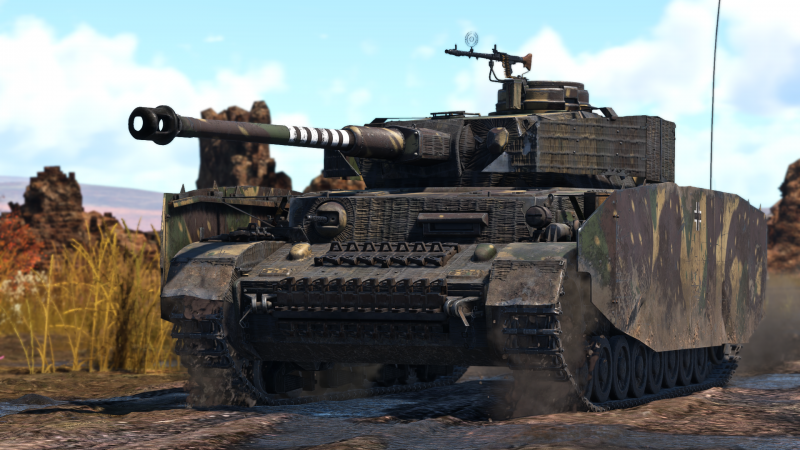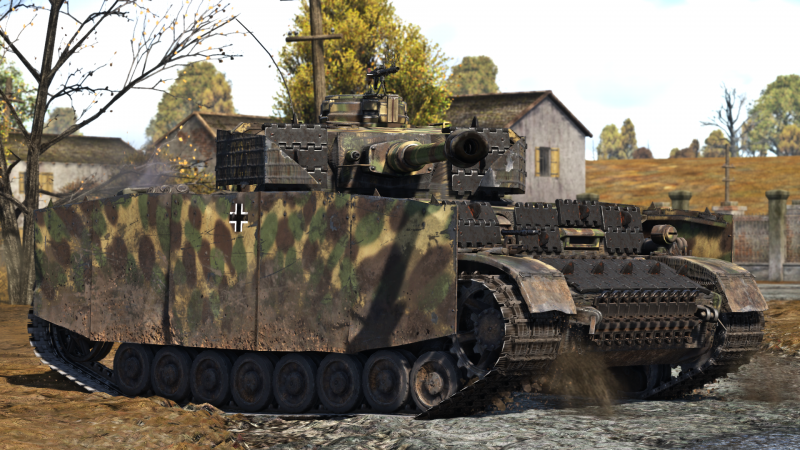Pz.IV H
| This page is about the German medium tank Pz.IV H. For other versions, see Pz.IV (Family). |
Contents
Description
The Panzerkampfwagen IV Ausführung H (Panzer IV H) (Sd.Kfz. Index: Sd.Kfz. 161/2) is the eighth variant of the Panzerkampfwagen IV medium tank family. The introduction of the long-barrelled 7.5 cm gun-armed Panzer IV G substantially altered the employment of the Panzer IVs within the German Wehrmacht. In 1942, the long-barrelled 75 mm Kampfwagenkanone (KwK) 40 L/43 tank gun were more than capable of dealing with the majority of tanks on the battlefield. Better armoured Panzer IVs were proposed due to their exceptional performance on the battlefield. This would result in the Panzer IV H variant being introduced. It was essentially the same vehicle as the Panzer IV G variant, with minor changes to simplify the manufacturing process and reduce production time. The Panzer IV H would become the ultimate backbone of the German Wehrmacht Panzer divisions from 1943 until the end of World War II due to its large numbers, firepower, and enhanced armour. From May 1943 onwards, the Panzer IV H, like many other German armoured vehicles, received 5 mm side skirt armour plates upgrades known as Schürzen. Their primary function was to provide protection against Soviet anti-tank rifles. Six thin armour plates were installed on either side of the Panzer IV H hull. Additional armour plates were added to entirely encase the turret, leaving only the front open for the main gun. In addition, the Panzer IV H was outfitted with a slightly modified 75 mm KwK40 L/48 tank gun. This gun has a slightly longer barrel than the previous Panzer IV G variant's 75 mm KwK40 L/43 tank gun, which offered slightly better armour-penetrating capability. Finally, it was the only Panzer IV type that received the Zimmerit anti-magnetic paste modification. While it was intended to be applied largely to the tank's flat surfaces, some tank crews just smeared the paste all over the tank. While newly manufactured tanks were applied with the paste at the factory, tank units were given the necessary equipment to do it on the battlefield by themselves as well.
Introduced in the Closed Beta Test for Ground Forces before Update 1.41, the Panzer IV H variant is a significant step forward from the Panzer IV G variant. The addition of 5 mm side skirts, known as Schürzen, is the most noteworthy difference. However, they were easily lost during conflicts, and this is accurately reflected in the game. Furthermore, firepower has been slightly improved through the integration of a longer-barrelled KwK40 L/48 tank gun. Overall, it is a tank that plays similarly to the earlier Panzer IV F2 and Panzer IV G. However, due to the addition of Schürzen plates, which add a lot of weight to the tank, the Panzer IV H is slightly slower than the other variants.
General info
Survivability and armour
Armour type:
- Rolled homogeneous armour
- Cast homogeneous armour (Cupola)
| Armour | Front (Slope angle) | Sides | Rear | Roof |
|---|---|---|---|---|
| Hull | 80 mm (11-12°) Front plate 20 mm (73°) Front glacis 80 mm (13-14°) Lower glacis |
30 + 5 (6°) mm | 20 mm (4-15°) | 10 mm |
| Turret | 50 mm (11°) Turret front 50 mm (7-29°) Gun mantlet |
30 (23-26°) + 5 (0-1°) mm | 30 (15-17°) + 5 mm | 16 mm Front 25 mm Rear |
| Cupola | 95 mm | 95 mm | 95 mm | 25 mm |
Notes:
- Suspension wheels are 15 mm thick while tracks are 20 mm thick.
- The hull and turret side is protected by an extra 5 mm thick plate to provide protection against HEAT and HE rounds.
- Add-on Armour gives an additional 20 mm of armour can be added to the front facing surfaces.
The armour of the Panzer IV H is almost identical to the previous Panzer IV with exception of the up-armoured hull armour from 50 mm (+ 30 mm applique armour) on the Pz.IV G to a 80 mm solid armour on the Pz.IV H. This tank also has added side skirts that adds an extra 5 mm of rolled homogeneous armour, and as it is spaced, it may add some nice protection against HEAT shells.
However, the Panzer IV Ausf. H's armour is vulnerable to most front shot engagement, especially so if no serious attempt is made in compound angling. The front plate in its unsloped format is an enticing target, but beware to not hit the front sloping glacis right in front of it as that area has a tendency to bounce everything. Also, avoid hitting straight into the ball machine gun and driver's port in the front as these also have a tendency to nullify an armour-piercing shot. When using APHE rounds, simply hit centre mass of the front plate and let the post-penetration effect do the rest.
In the case of a vehicle with a gun simply unable to penetrate this front plate, aim towards the turret that still retains a 50 mm front plate. Even the weaker non-autocannon armaments can penetrate through this front plate and incapacitate the turret crew. Aim for the turret left side (right side when shooting it) to knock out the gunner and if using ammunition with explosive filler, also ruin the gun breech, loader and commander. Then get around the side and chip away at weak spots until the threat is destroyed.
Alternatively, aim at the Panzer IV from its long vulnerable sides in cases where its turret traverse cannot keep up with a flanking manoeuvre or catching it in an ambush. The interior is fully stocked with ammo racks even when the user is taking a minimum load. Moreover, the fuel tank resides at the very bottom of the centre of the tank, so a penetrating shot with APHE will either detonate the ammunition, set the tank on fire, or knock out a good portion of the crew, if not fully destroy the tank with all three effects.
In every case scenario, it is to the benefit of the surviving player to fire the first shot against the Panzer IV Ausf. H above all else, as it would deny the Panzer IV H even a chance to use its high-penetrating 75 mm gun.
Mobility
| Game Mode | Max Speed (km/h) | Weight (tons) | Engine power (horsepower) | Power-to-weight ratio (hp/ton) | ||||
|---|---|---|---|---|---|---|---|---|
| Forward | Reverse | Stock | AoA | Stock | Upgraded | Stock | Upgraded | |
| Arcade | 43 | 9 | 26 | 0.35 | 465 | 572 | 17.85 | 21.67 |
| Realistic | 39 | 8 | 265 | 300 | 10.17 | 11.36 | ||
Modifications and economy
As with most tanks make sure you research "Parts" and "FPE". Then focus on researching "Pz.Gr. 40" (APCR shell) so your tank can stand the chance against heavily armoured vehicles like the Panther. After progressing this far into the unlock tree "Artillery" should be taken swiftly as well. Accuracy is decent, so sidestepping over to the mobility upgrades to aid the bad acceleration is not a bad idea, in particular "Filters" and "Transmission" are useful.
Armaments
Main armament
| 75 mm KwK40 L48 | Turret rotation speed (°/s) | Reloading rate (seconds) | |||||||||||
|---|---|---|---|---|---|---|---|---|---|---|---|---|---|
| Mode | Capacity | Vertical | Horizontal | Stabilizer | Stock | Upgraded | Full | Expert | Aced | Stock | Full | Expert | Aced |
| Arcade | 87 | -10°/+20° | ±180° | N/A | 13.3 | 18.4 | 22.4 | 24.8 | 26.4 | 7.67 | 6.79 | 6.25 | 5.90 |
| Realistic | 8.3 | 9.8 | 11.9 | 13.2 | 14.0 | ||||||||
Ammunition
- PzGr 39 - Armour-piercing capped ballistic cap shell - This is your main ammo type, always use this if you think it can penetrate enemy armour. It deals the most damage because of its explosive filler.
- Hl.Gr 38B - High-explosive anti-tank shell - it is recommended to completely avoid this kind of shell as its performance is vastly inferior in all aspects compared to APCBC or APCR ammo used by this tank.
- PzGr 40 - Armour-piercing composite rigid round - This type of ammo should be used only if you are having trouble penetrating your opponent, or trying to hit a fast-moving tank at some distance. However, its damaging potential is much lower because it has no explosive filler to further enhance damage after the penetration.
- Sprgr. 34 - High-explosive shell - You should carry only very few of these. They are useless against anything other than unarmoured AA vehicles, to which it is lethal.
- K.Gr.Rot Nb. - Smoke shells are useful to blind enemy vehicles that block your advance while being too remote for you to disable.
| Penetration statistics | |||||||
|---|---|---|---|---|---|---|---|
| Ammunition | Type of warhead |
Penetration @ 0° Angle of Attack (mm) | |||||
| 10 m | 100 m | 500 m | 1,000 m | 1,500 m | 2,000 m | ||
| PzGr 39 | APCBC | 145 | 143 | 130 | 116 | 104 | 93 |
| Hl.Gr 38B | HEAT | 80 | 80 | 80 | 80 | 80 | 80 |
| PzGr 40 | APCR | 182 | 177 | 159 | 140 | 122 | 107 |
| Sprgr. 34 | HE | 10 | 10 | 10 | 10 | 10 | 10 |
| Shell details | ||||||||||||
|---|---|---|---|---|---|---|---|---|---|---|---|---|
| Ammunition | Type of warhead |
Velocity (m/s) |
Projectile mass (kg) |
Fuse delay (m) |
Fuse sensitivity (mm) |
Explosive mass (TNT equivalent) (g) |
Ricochet | |||||
| 0% | 50% | 100% | ||||||||||
| PzGr 39 | APCBC | 770 | 6.8 | 1.2 | 14 | 28.9 | 48° | 63° | 71° | |||
| Hl.Gr 38B | HEAT | 450 | 4.4 | 0.05 | 0.1 | 872.1 | 62° | 69° | 73° | |||
| PzGr 40 | APCR | 990 | 4.1 | - | - | - | 66° | 70° | 72° | |||
| Sprgr. 34 | HE | 550 | 5.74 | 0 | 0.1 | 686 | 79° | 80° | 81° | |||
| Smoke shell characteristics | ||||||
|---|---|---|---|---|---|---|
| Ammunition | Velocity (m/s) |
Projectile mass (kg) |
Screen radius (m) |
Screen deploy time (s) |
Screen hold time (s) |
Explosive mass (TNT equivalent) (g) |
| K.Gr.Rot Nb. | 540 | 6.2 | 13 | 5 | 20 | 50 |
Ammo racks
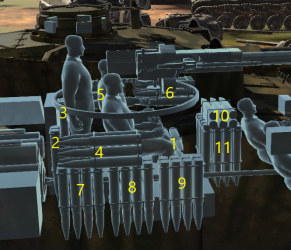
| Full ammo |
1st rack empty |
2nd rack empty |
3rd rack empty |
4th rack empty |
5th rack empty |
6th rack empty |
|---|---|---|---|---|---|---|
| 87 | 84 (+3) | 82 (+5) | 80 (+7) | 72 (+15) | 63 (+24) | 54 (+33) |
| 7th rack empty |
8th rack empty |
9th rack empty |
10th rack empty |
11th rack empty |
Visual discrepancy |
|
| 46 (+41) | 38 (+49) | 30 (+57) | 24 (+63) | 1 (+86) | No |
Notes:
- Racks are modeled by sets of 2 shells and disappear after both shells in the set have been shot or loaded.
- Racks 5 and 6 have a shell set in common.
- Sides empty: 30 (+57) shells.
Machine guns
| 7.92 mm MG34 | ||||
|---|---|---|---|---|
| Mount | Capacity (Belt) | Fire rate | Vertical | Horizontal |
| Coaxial | 3,000 (150) | 900 | N/A | N/A |
| Pintle | 2,000 (150) | 900 | -10°/+25° | ±180° |
Usage in battles
This tank can be described in one word: capable. While this version of the Panzer IV isn't nearly as renowned and feared as the Ausf. F2 or Ausf. G variants, it is still a very capable medium tank. The Pz.Kpfw. IV Ausf. H has a new gun that, while not that different to the guns on the F2 and G, still packs a deadly punch at its BR. The armour is meh, with a paltry 50 mm of armour at the front of the turret, and 80 mm of armour at the front of the hull. This makes you an easy target for tanks like KV-2s, T-34-85 (D-5T)s, and M4A3E2 Jumbos among others. But, with some careful play and some creative use of angling, you can bounce some shots from equal rank tanks, and destroy tanks at the top of your BR range. Mobility of this tank is lacking, albeit not by much. (It is the heaviest version of the entire Panzer 4 series after all). It's acceptable, but it will still take time for it to accelerate to its top speed, as your engine is underpowered and your tracks are narrow, which results in poorer cross-country performance than comparable tanks.
The Pz.Kpfz IV Ausf. H is a capable, versatile tank, perfect for sniping, ambushing, flanking, and second line defence. Make use of its accurate gun for hitting the enemy from a distance. But keep in mind its weak turret armour should return fire come your way. This tank also works very well supporting heavy tanks. Hide behind a friendly heavy that can tank the damage, while you can pop out and destroy the enemy if your teammate can't. Or you can use your decent mobility and get around to shoot into the enemy tanks flanks. In an equal BR rank or lower, you can reliably bounce shots if angled properly, but remember that frontal confrontation in a full up-tier can lead to a quick end.
Tactics-wise, on an open map like Kursk, make like a true German tank and hit the enemy from range. Don't bother going in close, as your advantages lie at range. On a city map like Advance to the Rhine, go for flank routes, or stick with your heavies, giving them more firepower should they need it. Remember to keep the frontal armour angled as you go around corners to bounce any shots.
Although most tanks in Rank III can destroy you pretty quickly, the tanks you need to avoid in open combat (if possible) are KV-2s, SU-152s, T-34-85 (D-5T)s, M4A3E2 Jumbos, and if you're playing in Arcade: Tigers and Panthers.
- For KV-2s, if it's looking at you, (And hopefully reloading) shoot at the flat of the turret below the mantlet. Its flat, relatively thin armour, and your shell should go right through and take out everyone and everything in the turret. From the side, shoot it in the side of the hull (At a 90-degree angle for best effects) to ignite the fuel tanks and maybe even detonate the ammo. Shooting the turret isn't recommended unless for knocking out the gunner or the breech, as there are a lot of crew members in there, and the shells in the turret rarely ignite. Trying to destroy it that way will take time.
- For SU-152s, shoot to the right of the gun, above the driver's viewport, and it will wreck everything inside. If that's an option, try to get around it. It is a casemate after all. Once you're on its side, shoot it in the crew compartment to obliterate it.
- For T-34-85 (D-5T)s, it is imperative you get the first shot off, as their 85 mm will go through your armour with little difficulty, and knock out your entire crew. Don't shoot the turret unless you have no other option, as it's incredibly unreliable and prone to bouncing your shot. Instead, shoot the turret ring right below the turret. This usually will decimate the entire crew of the tank. Pay close attention not to hit the driver's hatch as it's actually more armoured than the glacis itself.
- M4A3E2 Jumbos will give you the hardest time, as their frontal armour is nigh impenetrable, aside from the machine gun port. It's a small, unreliable target, but it's your only chance of penetrating the Jumbo from the front. If you're lucky and catch a Jumbo on its side, shoot it in its hull. As its Turret side and rear armour is still thick enough to block your shots. Also, keep in mind, that if the Jumbo is showing its side while angling toward you, that the side armour behind its tracks is very thinly armoured. Try shooting there if you can. There is a chance you can detonate its ammo rack.
Pros and cons
Pros:
- 75 mm KwK40 L/48 gun can destroy most equivalent tanks with stock rounds, with APCR for more heavily armoured vehicles
- Great gun accuracy
- Good turret traverse
- Good gun depression of -10°
- 5 man crew, able to spare 2 casualties before combat efficiency drops
- Decently fast and manoeuvrable for the battlefield
- 80 mm of frontal armour that can absorb some damage when angled properly, and even resist shells in long-range engagements
- Access to 20 mm of additional armour in the form of T-34 tracks (effectively 15 mm RHA) that cover almost the whole of the front of the hull and the turret armour
- Side-skirts can soak up HE and HEAT shells, as well as bomb and rockets at a sufficient distance
Cons:
- Flat armour on all sides
- Side armour is weak, very vulnerable to 20 mm autocannons at close range
- Very circumstantial protection. Only the upper front vertical glace is actually the listed 80 mm thick.
- Small gun mantlet, with weak 50 mm frontal turret armour
- Despite its upgrades, still only has 10 mm of roof armour, making it vulnerable to 12.7 and 20 mm AP shells fired from aircraft
- Cramped turret crew space means that one hit can knock out entire turret crew
- Cupola extends up from the profile and can be a weak point for enemies to shoot at
- Like all Panzer IV models, ammo racks all over the hull and are likely to be hit
- Heaviest of the Panzer IV model, consequently it is the slowest of them all
- Acceleration is mediocre
- Poor cross-country performance due to the underpowered engine and narrow tracks
- No smoke grenade dischargers
History
Development
The Pz.Kpfw. IV's creation, like its predecessor the Pz.Kpfw. III, was devised by Heinz Guderian, where he envisioned a support tank to be used to handle anti-tank guns and fortifications. The Panzer IV was to work alongside the more numerable Panzer III in Panzer Divisions (three company of IIIs and one of IVs) to engage the enemy, giving the role of fighting enemy armoured forces to the Panzer IIIs. The tank was to have the short 75 mm Howitzer as its main armament and have a weight limit of 24 tons. MAN, Krupp, and Rheinmetall-Borsig worked on the development of the tanks, but the Krupp's model was selected for further testing.
The chosen model from Krupp once finished used a leaf-spring double-bogie system for its suspension, doing away the proposed interleaved or torsion bar suspension system earlier devised. The vehicle held a crew of five, the commander, gunner, loader, radio operator (also the hull machine gunner), and driver. Though it looked symmetrical, the Panzer IV turret was actually offset to the left of the chassis centre line a bit while the engine was also offset to the right, this was to allow the torque shaft to turn the turret. The offset also meant that more of the ammo is held on the right side of the tank in storage areas. The Panzer IV was then accepted into service and production began in 1936.
Panzer IV Ausf. H
In the latter part of World War II, the Panzer IV in its base form was deemed inadequate against the new tanks the Allies have, the Soviet T-34 and American M4 Shermans was able to come toe-to-toe with the Panzer IV, if not better than it. Germany rapidly upgraded their Panzer IV to compete with the enemy, mainly the armour and gun. From the Ausf. C to the Ausf. G, the armour increased from the original 20 mm to 80 mm thick and the original KwK 37 L/24 75 mm Howitzer to the longer KwK40 L/48 75 mm.
The Panzer IV Ausf. H began production in June 1943. The 80 mm front glacis armour is now a single piece rather than attached via weld or bolt. Zimmerit paste is also added onto the Panzer IV hull to prevent the use of magnetic anti-tank mines. Schürzen (side skirts) on the hull added 5 mm thickness while the turret added 8 mm thickness, plus its application as spaced armour improved its efficiency. A common complaint of the Schürzen (side skirts) was that it was easy for the skirts to just fall off by brushing against the foliage. The Ausf. H return rollers were changed from rubber-rimmed to cast steel. All these modifications increased the tank weight to 25 tons, and despite the use of a new suspension, the cross-country speed dropped to only 10 mph (16 km/h). Despite that, the Panzer IV Ausf. H would go on to be the most produced Panzer IV variant. These features pushed the Panzer IV's limits to its maximum capacity. An attempt to mount the Schmalturm found on the Panther Ausf. F, called the Pz.Kpfw IV Schmalturm, failed and only further proved this point.
The Panzer IV Ausf. H stayed as the main German tank alongside the Panther tanks throughout the rest of the war. The 80 mm thickness of the frontal armour could withstand the M4 Sherman's 75 mm gun, and the 76.2 mm gun of the T-34. The Ausf. H served in all combat theatres past 1943, from the Battle of Kursk to the Battle of France, and the Ardennes Offensive. Many were lost due to combat or from lack of fuel and supplies and had to be abandoned. The rapid loss of the Panzer IVs in the German inventory caused a simplified variant to be produced. Designated the Panzer IV Ausf. J, the construction was simplified and the internal mechanics were modified, but the variant is a retrograde of the Ausf. H.
Twenty Panzer IV Ausf. H went to Spain in 1943, which held them as the best tanks they had in their inventory. Spain sold them to Syria in 1967. Around 130 Panzer IVs of various variants made it to Syria in the 1950s and 1960s. These Panzer IVs served the Syrians alongside T-34-85s, T-54s, and T-55s during the Six-Day War against Israel.
| Archive of the in-game description | |
|---|---|
|
The Ausf. H variant was the most mass-produced tank of this type. It was manufactured by the factories of three companies: Krupp-Gruson AG, VOMAG, and Nibelungenwerke. The first 30 tanks under this designation rolled off of the conveyor belt in April 1943. The front plate of the roof turret was thickened to 16 mm, and the rear plate to 25 mm. All Ausf. H tanks received a Zahnradfabrik ZF SSG77 transmission, reinforced drives with cast drive wheels and Schurzen side skirts, which protected the lower part of the sides from anti-tank and hollow-charge projectiles. The radio antenna was moved to the rear of the hull. From the summer of 1943 onward, to simplify production, solid-rolled 80 mm plates replaced the extra 30-mm-thick outer armour. In September of the same year, the vertical surfaces of the tanks were coated with Zimmerit paste for protection against magnetic mines. From December 1943 onward, the front plates of the hull were merged into a single plate, improving the new front's resistance against shell impacts. In 1944, the tanks were produced with all-metal supporting rollers. Later Ausf. H models received a turret mount for the MG42 machine gun in the commander's cupola, as well as a vertical rear armour plate instead of the oblique plate featured on all previous variants of the tank. The driver's periscope viewing device was removed. During production, many other changes were implemented to reduce the tank's cost and simplify its manufacture. Manufacturing of the Ausf. H continued until 1944, and 3960 units were made in all. Tanks of this variant were supplied to Hungary and Bulgaria. In 1950, the Bulgarian army was still operating 11 of these vehicles. In Operation Citadel, Pz.Kpfw. IV tanks accounted for nearly 60% of all German tanks. Most of them were G and H variants. The Pz.Kpfw. IV Ausf. H proved itself to be a reliable combat machine. Its disadvantages included low manoeuvrability and speed. | |
Media
- Skins
- Sights
- Videos
See also
- Other Pz.IV armed with the 7.5 cm KwK40 L/48
External links
| Germany medium tanks | |
|---|---|
| Pz.III | Pz.III B · Pz.III E · Pz.III F · Pz.III J · Pz.III J1 · Pz.III J1 TD · Pz.III L · Pz.III M · Pz.III N |
| Pz.IV | Pz.IV C · Pz.IV E · Pz.IV F1 · Pz.IV F2 · Pz.IV G · Pz.IV H · Pz.IV J · Pz.Bef.Wg.IV J |
| Pz.V | VK 3002 (M) · Panther A · Panther D · Panther F · Panther G · Ersatz M10 · Panther II |
| M48 upgrades | M48A2 G A2 · M48 Super |
| Leopard 1 | Leopard I · Leopard A1A1 · Leopard A1A1 (L/44) · Leopard 1A5 · C2A1 · Turm III |
| Leopard 2 | PT-16/T14 mod. · Leopard 2K · Leopard 2AV |
| Leopard 2A4 · Leopard 2 (PzBtl 123) · Leopard 2A4M · Leopard 2 PL · Leopard 2A5 · Leopard 2 PSO · Leopard 2A6 · Leopard 2A7V | |
| Trophies | ▀M4 748 (a) · ▀T 34 747 (r) |
| Other | Nb.Fz. · KPz-70 |
| USA | mKPz M47 G · M48A2 C |
| USSR | ◊T-72M1 |


